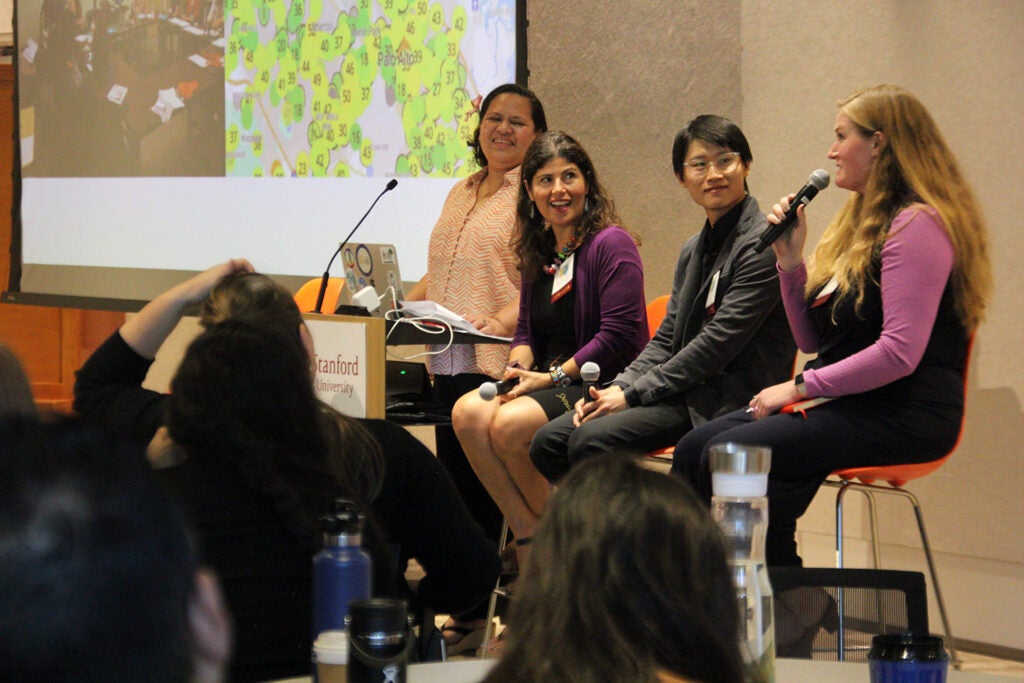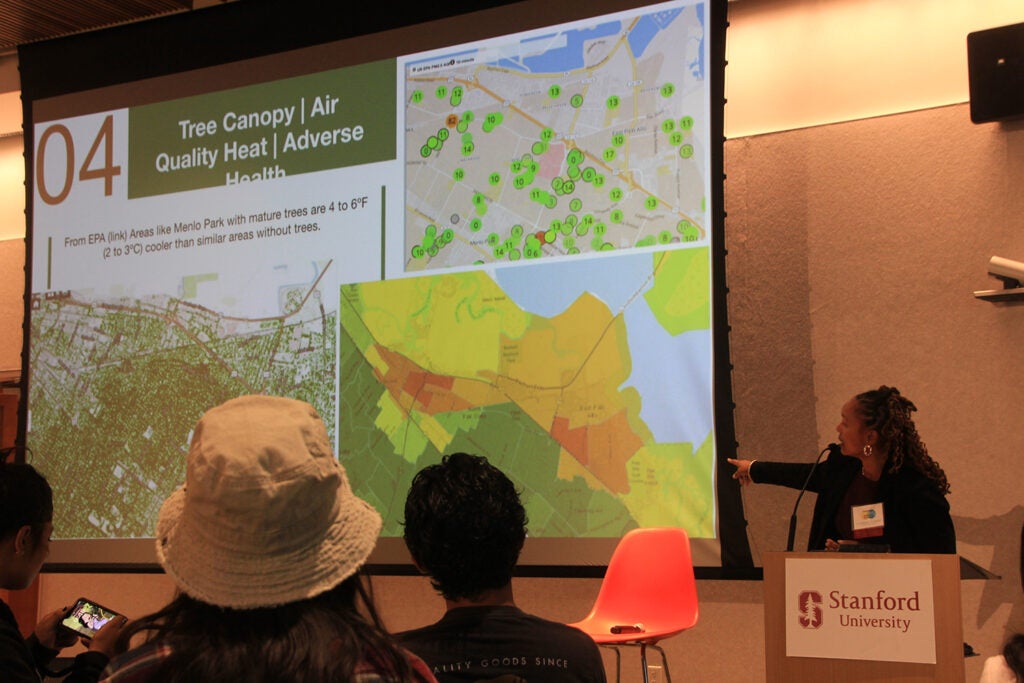San Mateo County Climate Summit highlights community-level adaptations
The first-of-its-kind gathering focused on climate change adaptation and prioritized collaboration among communities, researchers, government, philanthropy, and policymakers.
Attendees of the first-ever Climate Summit for San Mateo County discussed ways that community-engaged scholarship could help alleviate the day-to-day impacts of climate change affecting some of California’s most vulnerable residents.

Professor Desiree LaBeaud of Stanford School of Medicine, and Derek Ouyang, research manager at RegLab react to an answer by post-doctoral researcher Natalie Herbert of the Woods Institute, during a light moment they shared on a panel about translating science into policy and practice. Pictured at the podium is Violet Wulf-Saena, executive director of Climate Resilient Communities. (Image credit: Sarah Hubbard)
The event, which took place on Oct. 3 at Stanford’s Redwood City campus, convened nearly 200 people from community-based organizations, academia, government, nonprofits, and elected office.
The daylong gathering represented the first county-wide effort of community-based organizations to lead discussions on climate change adaptation. The event focused on reframing adaptation – from research to funding to policymaking decisions – around improving conditions for “frontline communities.” The term is used to describe neighborhoods where residents experience the first and the worst consequences of climate change. Often these are poorer communities of color that have been historically relegated to the least desirable areas, with greater exposure to events like flooding.
Among the 58 counties in California, San Mateo County is one of the most vulnerable to such climate change-related events.
“We have high exposure to sea-level rise, river-based flooding, wildfire, extreme heat, landslide, and drought,” said Petra Silton, the senior director of programs for Thrive Alliance, which co-hosted the summit with three community-based organizations, Climate Resilient Communities, Nuestra Casa, and Rise South City.
“Adaptation to these evolving conditions means changing both our social structures and our built environment in a way that leaves nobody behind,” Silton added.
The summit focused attention on the experiences and concerns of communities that often have been left out: those residing in the “forgotten South Coast” including Pescadero, South San Francisco, East Palo Alto, and the communities of Belle Haven on the bay, and North Fair Oaks in Redwood City.
In her welcoming remarks, Kathryn “Kam” Moler, vice provost and dean of research at Stanford, acknowledged the massive human toll from extreme weather events in places ranging from Pakistan to Florida. Engaging with communities in future research is critical, she said.
“It’s vitally important, I believe, for universities around the world to be studying not only the climate science that will hopefully give us ever-better predictions of these events but also working closely in community-engaged scholarship with the communities that will be deeply impacted by events that we know are coming,” Moler said.
The weather extremes wrought by climate change helped move Stanford’s community to urge the university to do more to meet this existential threat, Moler said. The new Stanford Doerr School of Sustainability was one of the outcomes. “As Stanford’s senior research officer… it had been a huge passion for me, working with thousands of other people, to make it happen,” Moler said. The school’s opening on Sept. 1 was part of the university’s journey of purposeful engagement, education, and research – “and hopefully, with deeper engagement with partners like you.”
Beyond sea-level rise
In one summit discussion, panelist Derek Ouyang, the research manager at Stanford’s Regulation, Evaluation and Governance Lab, described two projects that were influenced by community input, and how a third benefitted from connections with the community.

Menlo Park Council member Cecilia Taylor described the disinvestment and inequities in her neighborhood of Belle Haven, a community annexed by the city more than 70 years ago, including lack of public transit, medical and pharmaceutical services, tree canopy, updated safety and hazard mitigation reports, and more. “So, when I think about environmental justice, all these pieces need to be included.” (Image credit: Lisa Chung)
In a 2020 project, when discussions with North Fair Oaks residents revealed that climate change was impacting the community in multiple ways beyond flooding, including oppressively hot days, lack of tree cover, and poor air – frequently driven by wildfire – that exacerbated conditions like asthma or poor respiratory health, the researchers requested that the scope of their funding grant be expanded.
“We had to take the community’s side on that point and really argue and negotiate with the county for our very, very structured funding to be more flexible than just sea-level rise planning,” Ouyang said.
Following community input, Stanford researchers also completely changed the framing of a related 2021 study on the impact of sea-level rise for San Mateo County, Ouyang said, by shifting the focus from county-wide damage to vulnerable neighborhoods where increased financial instability displaced households, and ways to prevent that from happening.
A third study, which is ongoing, builds on these two earlier studies, said panelist Natalie Herbert, a postdoctoral scholar at the Stanford Woods Institute for the Environment. It seeks to better understand how these other climate hazards affect households, discover potential strategies for resilience, and test whether the uptake of air purifiers and air quality monitors can improve health.
Shaping through community needs and voices
In another panel discussion about community leadership aimed at shifting the dynamics of policymaking, Regina Wallace Jones, BS ’96, a member of the East Palo Alto City Council, said that in order to be inclusive, members of the different sectors represented at the gathering need to learn how to relate to one another, particularly because they have differing, unsaid, norms. “Once everyone feels like they are at the table, then we can start learning and expanding our knowledge together.”
In the same panel discussion, Everardo G. Rodriguez, founding president of the North Fair Oaks Community Alliance and an assistant rare books librarian at Stanford, said it takes time to identify how working with the community can be productive.
It’s also hard, said Dana Brechwald, program manager of Adapting to Rising Tides for the Bay Conservation and Development Commission (BCDC), a 57-year-old state agency focused on protecting and enhancing San Francisco Bay. In the past five years, in particular, Brechwald said, the BCDC has learned a lot about working with the community as it develops Bay Adapt, a regional consensus-driven strategy to protect communities from sea-level rise.
“It really helped us to understand that funding community priorities isn’t just about giving grants to communities, but it’s allowing the money that the government spends on its projects to be shaped by community needs and community voices,” said Brechwald, who was part of a summit panel on funding resources and accountability.
The experience has led the BCDC to create more opportunities for guidance through hiring staff, expanding compensation for environmental justice advisors and paid advisory board seats, and increasing its diversity in decision-making levels to help leadership.
New networks
The summit organizers built in discussion time and encouraged attendees to talk to those from different parts of the county or who worked in different sectors to spur the exchange of perspectives and create new networks. “I am very happy to see how many people in this room have been in conversation … with people in my community directly,” said keynote speaker Cecilia Taylor, a Menlo Park council member from Belle Haven. “That’s the collective effort we need to continue.”
The summit is expected to convene each year to make headway in policy changes and create meaningful solutions for the problems facing frontline communities.
The event was livestreamed to members of the Stanford community and the public. That included a viewing party at the Haas Center for Public Service open to students and staff.
The Climate Summit for San Mateo County was co-presented by Stanford University and supported by the Stanford Doerr School of Sustainability, the Haas Center, and the Office of Community Engagement as an OCE Regional Forum, periodic events that showcase regional collaboration and advance the university’s mission.